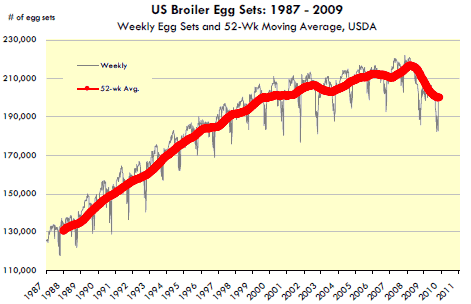



CME: Dismal Returns Lead to Cutbacks
US - Blizzard conditions across a good portion of the Midwest caused production disruptions to a number of beef and pork plants, write Steve Meyer and Len Steiner in their Daily Livestock Report (DLR) for 9 December.The USDA daily cattle slaughter numbers showed cattle slaughter down some 28,000 head or 22 per cent compared to the previous week. Hog slaughter on Wednesday was reported at 307,000 head, some 113,000 head or 27 per cent lower than a week ago. Some of the lost production will likely be made up on Saturday but not all of it. In the short term this will tend to limit supplies of beef and pork in the spot market but the effect will likely be short lived.
Normally a blizzard in this part of the country would be bullish for cattle prices as cold, wet weather negatively impacts cattle in feedlots Weather conditions have deteriorated significantly, with very cold temperatures across much of the Plains and Midwest. Nevertheless, cattle prices on Wednesday posted another sharp drop and many contracts established new life of contract lows.
Cutout values have been declining steadily in recent days, with beef salesmen offering ever lower prices to keep trucks moving. The choice cutout closed on Wednesday at $135.37, down $1.22 from the day before and the choice cutout has lost $6/cwt or 4.2 per cent in the last ten days. Beef steak cuts have been poor but, in our view, the main problem at this time is the poor performance of round cuts, beef cuts used for roasts, etc, which are popular at this time of year. Consumers clearly have plenty of inexpensive options in the marketplace at this time and beef is feeling the pain.
One of those inexpensive options is chicken, a presumed favorite in times of economic distress. The broiler industry cut back sharply following dismal returns in 2008, which eventually caused the market leader, Pilgrim’s Pride, to declare bankruptcy a year ago. Since then, a number of hatcheries were closed and plants were shut down or idled. For an industry that was used to steady growth, the last two years have been especially painful. The question is: how long until chicken production starts moving up again.
It is an important question as it has an impact not just on broiler prices but the entire meat complex. After all, chicken consumption accounts for almost 40 per cent of red meat and poultry consumption in the US. The latest USDA data shows that producers set 200.2 million eggs for the week ending 5 December, 0.27 per cent lower than a year ago and 4.1 per cent lower than the five year average. For the same week, producers placed 166.3 million chicks, almost the same as a year ago but still 3.3 per cent lower than the five year average.

Given current egg sets and somewhat better productivity, the expectation is for US broiler production in Q1 of 2010 to slightly higher than a year ago. Longer term, however, the industry will likely be careful as to how quickly it expands. The main issue at this time is poor demand at foodservice and until the sector recovers, broiler supply growth will likely be muted.











